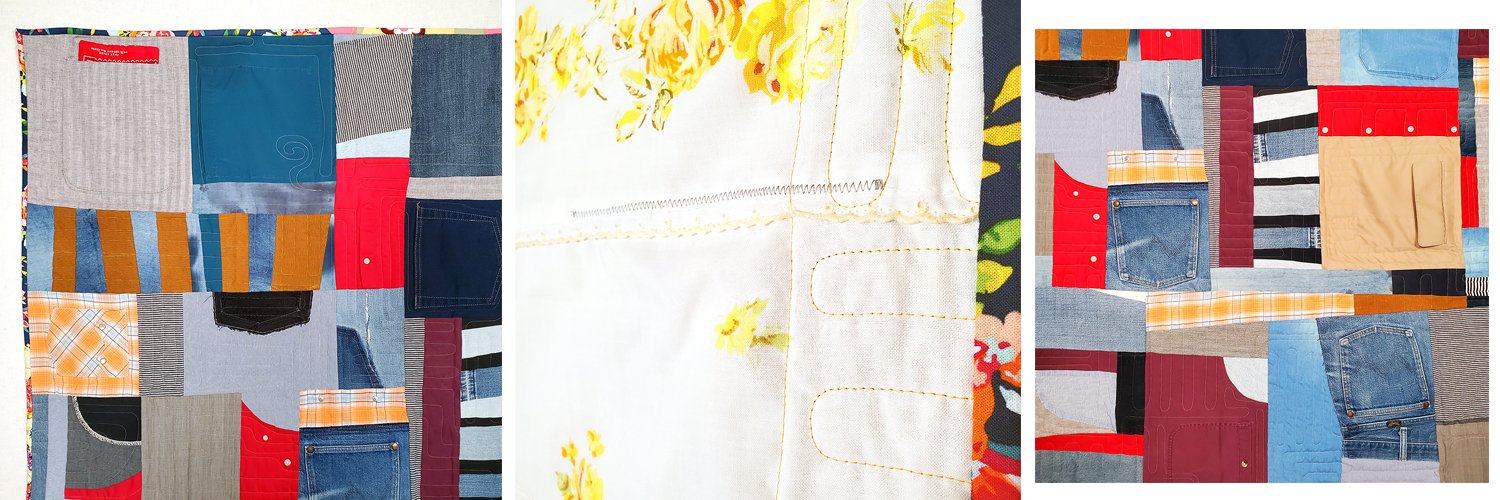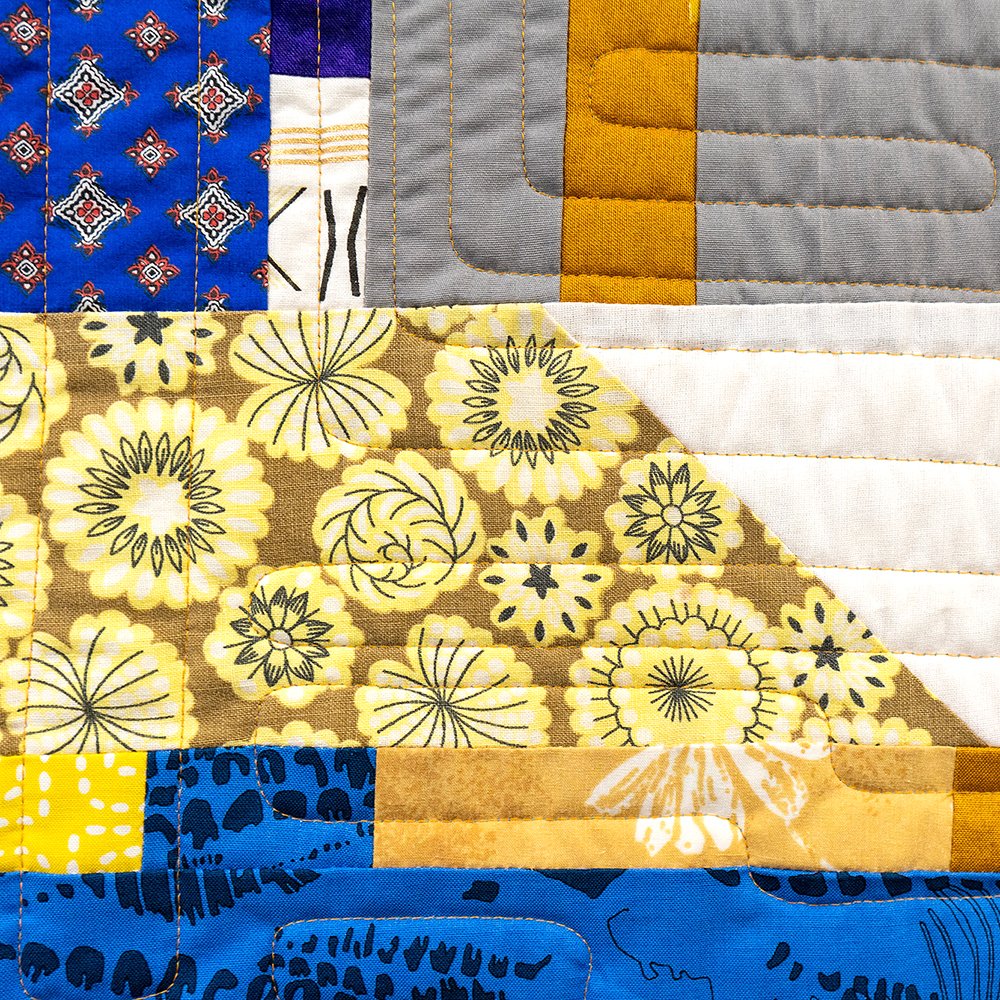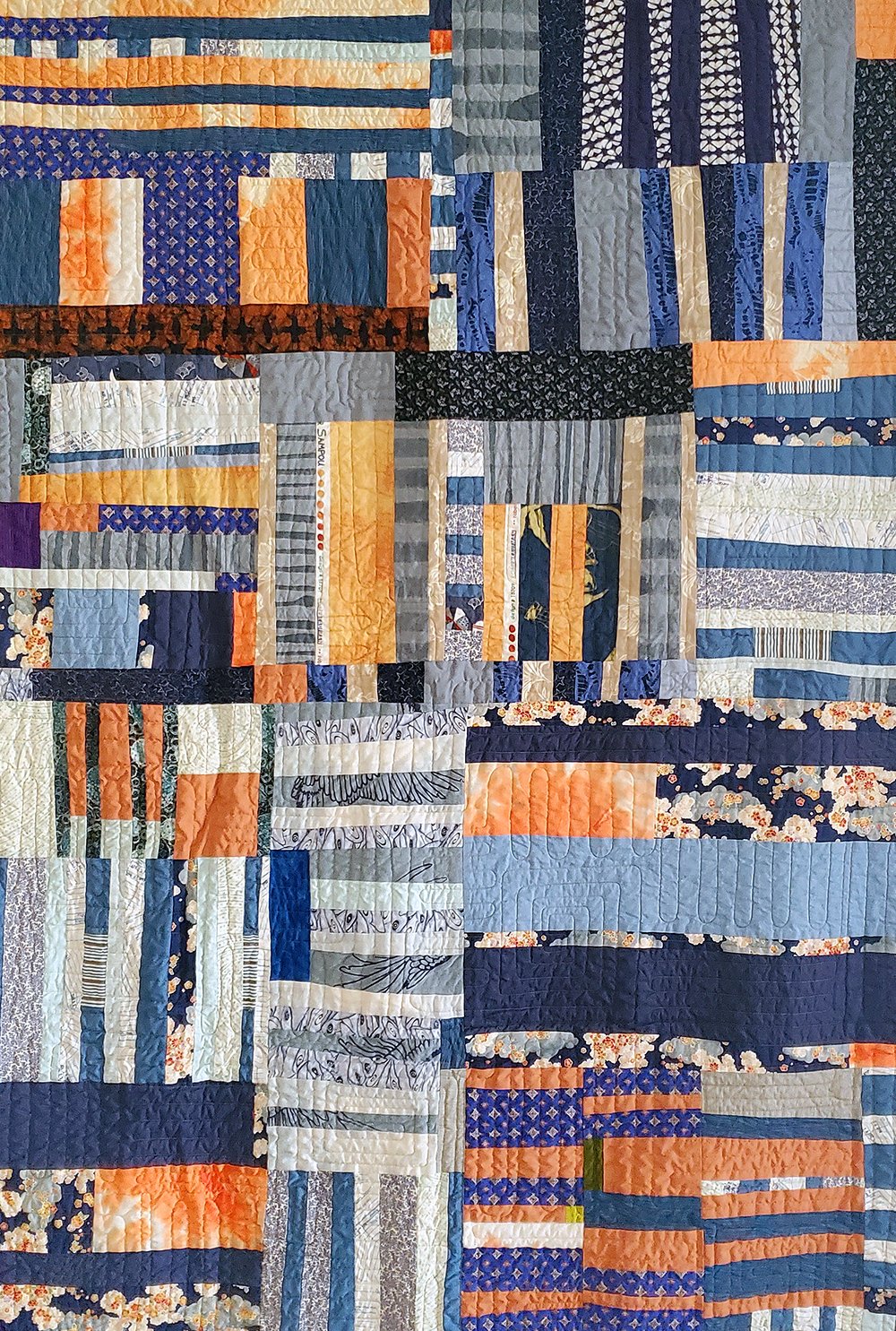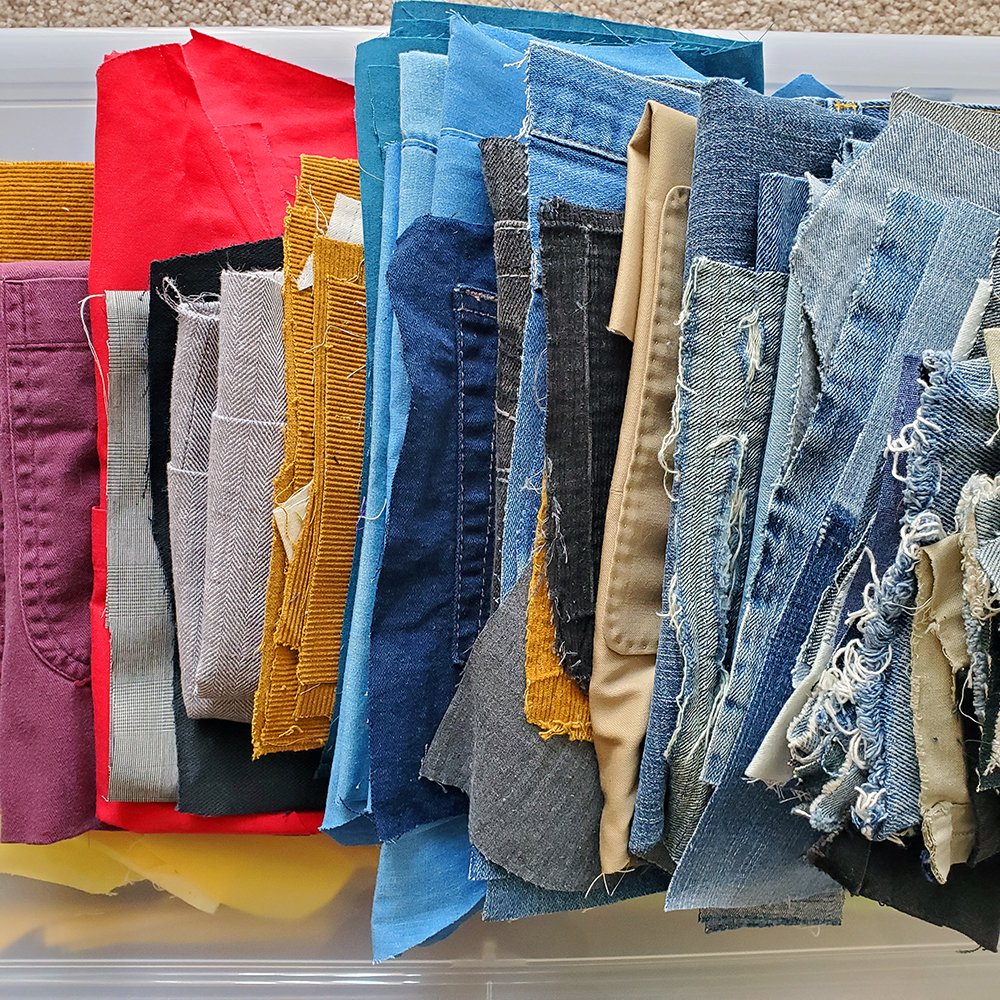My Hand Sewing Kit
I've just delivered a stack of newly finished quilts to a professional photographer. To get ready for that delivery, I spent most of last week sewing labels and sleeves onto quilts. That's a lot of time hanging out with my hand sewing kit.
How about a little tour? It really does all fit into that mini metal lunchbox pictured above. (Except for those two spools of thread. Choices were made.)
Top row, L-R: Needle threader (unused), sake cup pincushion with pins and wonderclips clipped around the rim; Liberty of London pincushion for backup pins (made by my friend Elizabeth)
Row 2: Scissors, spools of thread in various weights
Row 3: 2 bobbins with more thread (I try to keep a range of light to dark colors handy), lip balm*, hand balm, heavier threads for hand quilting, measuring tape
Row 4: Bandages (not so much for stab wounds, but for when my fingers get too sweaty), mini-mint tin with needle grabbers, sticky thimble patches, and other aids, adorable needle holder that looks like lipstick, another needle grabber, one button, magnetic needle minder, roll of washi tape, thimble (unused), backup scissors, one paper hexie
* Lip and hand balm because who wants to get all snuggled in to their hand sewing nest with the tv on and realize oh crap, my skin is dry, I have to get up to get the stuff? No one, that's who.
Here's a closer look at my beautiful sake cup pincushion. (I think the cup was made by Ty Illgen, please correct me if I'm wrong.)
What's in your sewing kit? More importantly, why do you keep it in a cookie tin? :)
Hospital Corners (It's the Little Things)
UPDATE: The Fold is now weekly!
This is an excerpt from my monthly newsletter, The Fold, originally published in March 2022. Sign up here to receive The Fold every month in your email inbox. (Be sure to check your email and spam folders for the confirmation.)
It's The Little Things
You know how we have these pet peeves that seem relatively insignificant compared to *gestures around*, but they become that thing you would go to the barricades for?
Mine is pockets. I would plant my flag on the hill of All Clothing Should Have Pockets. As long as we're still segregating clothing by gender (unnecessary, see Degendering Fashion), those clothes should have places to put things.
Hence the title of this quilt, Pockets, aka Can You Hold This For Me?
L-R: Detail of top left corner, detail of back including visible mending, detail of center
For the backing, I used a vintage bedsheet - yummily soft, faded and worn with time. As you can see in the photo above, there was a spot that needed repair before quilting. I'm a fan of visible mending.
Pockets is one of several pieces I've just added to my web store. (Click here to see what else is new.) You can read more about the process of creating Pockets here.
Hospital Corners - Still a Thing?
I used to think hospitals were scary places. But after a few inpatient stays (shout-out to autoimmune disease!) and sitting with my mom through some procedures, I've changed my tune. Hospitals are where we go to get the care we need. They have snacks, and socks, and warm blankets, and really really nice people helping you to get better. It's no suite at the Hilton, but there can be unexpected niceties.
Picture this: January 2021, pandemic, I'm in a hospital bed, and patients are not permitted to roam the hallways (for good reason). Late in the evening, a sound travels down the hall. It's warm, and warbling... it's a human voice. It's a man, and he's singing.
I thought, oh, someone's listening to a church service (it was a Sunday), or there's an opera special on TV. The next morning, there it was again. Again I thought, TV, or a video online or something. That afternoon, again.
My fellow sick person was singing. Like, trained, operatic style. A tenor. He continued to serenade us over the next few days. I didn't find out if he took requests, but he did get around to O Sole Mio the day I went home.
You just don't know where you're going to find beauty.
You know what I didn't find at the hospital? Hospital corners. Maybe they still do this in the military, but apparently it's not a thing in hospitals any more. They use the sheets with the elastic corners like us normal folks. Easier, and more practical.
Would you like to receive more in-depth stories, sprinkled with pictures and juicy links?
Click here to sign up for The Fold, generally delivered on the last Saturday of the month. (Be sure to check your email and spam folders for the confirmation.)
Omakase II: Out On The Town
Above: Omakase II: Out On The Town. Deconstructed garments (new and vintage) and additional cotton fabrics, machine pieced and quilted. 42 x 63 inches. $1140
Omakase II: Out On The Town
Omakase II: Out On The Town is now available for sale! Click here to purchase.
Want your own custom-made version of Omakase II? Commissions are now open! Visit the Commissions page to get started.
Continue reading for the story behind this quilt.
Do you ever get decision fatigue?
Are you ever faced with so many choices, either good or bad, that your brain just wants to crawl under the covers and weep? We've all been there. Don't ask me to order from a case of baked goods because I want one of everything. And two of those.
Luckily, there's another approach.
Omakase Quilting
Omakase is one of my all-time favorite words. It comes from Japan, and has no direct translation into English. We can get kind of close by saying things like pre fixe, dealer's choice, or surprise me.
The phrase omakase, literally 'I leave it up to you', is most commonly used when dining at Japanese restaurants where the customer leaves it up to the chef to select and serve seasonal specialties. The Japanese antonym for omakase is okonomi, which means you are choosing what to order. In American English, the expression is used by patrons at sushi restaurants to leave the selection to the chef, as opposed to ordering à la carte. The chef will present a series of plates, beginning with the lightest fare and proceeding to the heaviest dishes. The phrase is not exclusive to raw fish with rice and can incorporate grilling, simmering and other cooking techniques. - Wikipedia
Omakase is an expression of mutual trust. I trust the chef to bring me the most delightful selections available, and the chef trusts me to appreciate the meal and pay whatever they charge. (Full disclosure, I've never actually done this at a sushi restaurant, but it's on my bucket list.)
I've been applying this principle to improvisational quilting. I dip my hand (literally or metaphorically) into the Cosmic Fabric Bin, pull stuff out, and make something with it. I trust the process. Enter the Omakase series.
Omakase I: The Blue One. I made this during the summer of 2021 and donated it to the Palliative Care unit of my local VA hospital.
Quilters call this a stashbuster. Most of us have more fabric than we will ever use (guilty). My rational brain wants me to use each fabric in a highly specific and planned way. My intuitive brain wants me to grab a handful and just go to town.
This fabric pull was mostly from donations, and became a quilt that I made and donated around 2015.
This is the essence of improvisation: I trust myself.
I trust my intuitive brain to make decisions and connections that I wouldn't otherwise make. I let go. I park my verbal brain in front of Netflix or an audiobook so it doesn't interfere with the creative process.
Omakase II includes bits that were trimmed off of Omakase I. Because food metaphors are my love language*, here's another one: It's like the pot of soup that never gets cleaned all the way out, so the soup's "secret ingredient" is the history of every soup it's ever held. Scraps from one quilt often go right into the next one.
* Think sourdough starter. Or a well-seasoned iron skillet. I could go on.
Like what you see, but want it in a different size?
Or with purple and green fabrics?
Or as a square instead of a rectangle?
Start your custom quilt order today!
Step 1: Click here to answer your questions about ordering your custom quilt.
Step 2: Ready to start the commission process? Click here for sizes, prices, and payment terms.
Step 3: Book your call with me and we'll finalize the details. After I receive your deposit, I'll create your custom, made-to-order quilt!
So You Want to Donate Some Fabric
Above: deep thoughts. deep fabric-related thoughts.
Too Much Fabric
If you have any quilters in your life, you've probably heard them joke about how much fabric they have in their stashes.
When a quilter passes away, dollars to donuts they're leaving behind some fabric and unfinished quilt projects. Their loved ones may be tasked with cleaning out their home and dealing with the miscellaneous items that make up a life. I've been through this more than once. I know how difficult it is.
Maybe you are a fellow quilter, or just a fabric lover, and you're taking the opportunity to downsize your collection. Bravo!
For whatever reason, you are rehoming fabric. Excellent! There are a few different ways to go about this.
Maybe you already know a quilter and want to offer the fabric to them. This will probably do the trick, because it's hard for us to say no!
Don't know any other quilters? Buckle up, because you will soon. No matter where you live, there is a quilting guild within driving distance (probably within spittin' distance). Here's a worldwide directory of Modern Quilt Guilds. Here's a directory of other Quilt Guilds within the U.S.(Not in the U.S.? Fear not! Google quilt guilds in your area.)
Quilters tend to get together for monthly meetings, and there's often a "Free to Good Home" table! Contact your closest guild and ask if they're accepting donations. We love to share!
There are also charities that accept fabric donations, such as local chapters of Project Linus or Quilts of Valor. Google "donate fabric" and you'll get lots of options. Different charities have different guidelines, so again, it's best to ask what they need and can use.
Be a Mindful Donor
You may be going through a period of grief and stress. I understand, I've been there. Maybe rehoming these fabrics is difficult for you for emotional or logistical reasons. If that's the case, try and recruit a friend for help.
It's a good idea to at least look at each fabric before you donate. Are they clean and undamaged? Is there water or smoke damage? Mold? Do they come from a home with cats, dogs, or cigarette smoke? Is there any evidence of pests? (Just think how embarrassed you would be if you gave someone fabric that had mouse poop in it.)
Think of it this way: If you wouldn't want the fabric touching your body, it may be best to throw it away. (I know, we try to keep fabric out of landfills as much as possible. If you know of a good fabric recycling source, please tell me!)
If the fabric has that "long-term storage" smell but is otherwise undamaged, run it through a washer and dryer. Did the colors run? Did the fabrics fray a bit? Don't worry about it. Quilters are creative.
Flat fabric is happy fabric.
I’m going to say that again for the folks in the back.
Flat fabric is happy fabric.
If you're not able to iron the fabrics yourself, just fold them into stacks and put them into bags. If you're feeling ambitious, you can even sort them into prints, solids, by color, etc. The recipients will thank you!
Sarah, would you like my fabric?
My answer to this question used to be an unconditional "Yes!" Since then, my boss (me) has had to impose a few rules to keep the stash under control.
These are guidelines for my own quilting practice. Others' mileage may vary.
I will take a look at your fabric if:
It's 100% cotton. (Some wool is okay.) Denim is okay.
It's been washed and pressed.
There is no evidence of pests like moths or mice.
I especially love blasts from the past, i.e. vintage prints!
I'm not able to use:
Fabrics that are stretchy or slick.
Lace, crochet, or knitwear.
Fabrics with a loose weave that will fall apart if I cut into it.
Upholstery fabric.
Fabric that has been damaged by water, smoke, pests, etc.
Unfinished quilt projects with "traditional" patterns, such as Sunbonnet Sue (check your local guilds for this type of thing).
You Are Doing A Good Thing.
If you donate mindfully, you are doing your fellow person a kindness. You are about to make a quilter very happy! Thank you.
Want more in-depth stories, sprinkled with links, delivered monthly to your inbox? Sign up for The Fold. (Check your email and spam folders for the confirmation.)
You can also find me at Patreon, Facebook, Instagram, and Twitch.
Then Again Podcast Links
Many many warm fuzzy thanks to the folks at the Northeast Georgia History Center for having me on their podcast, Then Again! Episode 84 is called Patchworks of the Past & Present. You can find this episode on Then Again’s website, and also on Spotify (direct link here). I’m sure you can find it lots of other places, too. And while you’re at it, leave them a positive review!
Several times during our conversation, I told Marie I’d send her a link to this and that, so if you’re looking for those links, you’re in the right place! Enjoy.
Sarah's socials: Facebook, Instagram, Twitch
Cerulean Gallery in Amarillo and Dallas, TX
Great YouTube channels for beginning quilters: The Crafty Gemini, Just Get It Done Quilts
Gees Bend Quilters and the Souls Grown Deep Foundation
What is 'modern quilting'? (I'm not actually a huge fan of this organization, but this page does have a good explanation.)
Books I love:
The Improv Handbook for Modern Quilters by Sherri Lynn Wood
Rosie Lee Tompkins: A Retrospective (The BAMPFA is currently taking orders for the next printing of the catalog.)
A Piece of My Soul: Quilts By Black Arkansans by Cuesta Benberry (1923-2007)
Godharis (quilts from Western India): This is the exhibition I saw at the International Quilt Museum in Lincoln, NE: Collecting and Recollecting
Thanks again to Marie, Libba, and all the folks at the Northeast Georgia History Center! I encourage you to listen to their podcast, Then Again (not just the episode I’m in) for a wonderful, conversational look at history from all angles.































